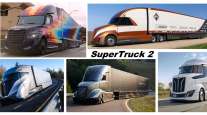Senior Reporter
Fuel Economy Improves for 9th Straight Year, NACFE Study Finds

Nineteen fleets tracked by the North American Council for Freight Efficiency showed fuel efficiency improvements last year, for the ninth straight year, but the gain was just 1% year-over-year as some fleets dropped certain fuel-saving technologies and as other factors such as extreme summer heat played a role in fuel consumption.
The results were recorded in NACFE’s 2016 Annual Fleet Fuel Study.
“There has been an increase in fuel efficiency every year since 2007,” NACFE’s Executive Director Mike Roeth told Transport Topics. There was a 3% increase in 2015, compared with 2014.

Some of the reasons for the smaller increase were hotter summer weather and the related increase in idling times; the turning away from certain technologies like 6X2 axle configurations and trailer tails; and fleets keeping older trucks longer amid a weak used truck market, Roeth said.
Nonetheless, the fleets in 2016 achieved an average fuel economy of 7.11 miles per gallon compared with the U.S. fleet average of 5.89 for the 1.7 million vehicles on the road, according to NACFE. Model-year 2017 trucks operated by the fleets in the study achieved 7.8 to 9.2 mpg with some even approaching 10 mpg.
The 19 fleets operate more than 71,000 tractors and 234,000 trailers of various ages.
The fleets, which represent 4% of the industry, provided their purchasing experience for the 85 technologies for tractors and trailers they procured from 2003 to 2016, yielding more than 21,000 data points, according to NACFE.
Mesilla Valley Transportation and U.S. Xpress participated.
U.S. Xpress Enterprises ranks No. 21 on the TT100 list of the largest for-hire carriers in North America while Mesilla Valley Transportation ranks No. 72.
The study identified the 10 most popular solutions ranked by the fleets: anti-idle electronic engine controls, aerodynamic hoods and fenders, aerodynamic bumpers, aerodynamic mirrors, engine parameters set for fuel economy, synthetic axle lube, full-height roof air fairing, driver training for fuel economy, synthetic engine oil and limiting truck speed to no more than 65.
Fleets ranked the 10 least popular options (in descending order): trailer nose cones, wheel covers-trailers, vortex generators, move from 6x4 to 4x2 tractor specs, fuel additives, liquified natural gas, tire pressure inflation-tractor, thermal storage system, tires filled using nitrogen and trailer under-tray or bogie fairing. NACFE noted that some of these are new technologies.
The number of available fuel-saving technologies grew to 85 compared with 69 the year before.
“What we are seeing is an improvement in the technologies, also they offer a better total cost of ownership, and different concepts or products that fill the same technology, with the same function,” Roeth said.
The fleet with the most involvement adopted 62% of the technologies, according to NACFE, which did not identify the fleet.
Automated transmissions, tire pressure systems, two-speed fan clutches, low viscosity oil and predictive cruise control all saw increased adoption by fleets. Trailer skirt technology had the quickest ramp-up to widespread adoption, according to NACFE.
The study also found a 2 1/2-year payback for the technologies that provide the majority of the savings for the fleets.
“This payback will improve in the future as higher adoption leads to lower upfront purchase prices,” the report stated.
However, “There is much work for the industry to do in order to improve confidence in the technologies for increased adoption and for the improvement in the total cost of ownership for these fleets to buy them at the levels expected by the regulators and required of the truck and trailer builders,” under the federal greenhouse gas Phase 2 regulations for commercial vehicles ranging from Classes 3 to Class 8, the report said.
The Phase 2 rule mandates that truck, engine and trailer manufacturers sell equipment that put out lower emissions through improved fuel economy.
The Environmental Protection Agency announced Aug. 17 that it intends to revisit the trailer and glider kit portions of the rule, which is set to take effect in January.




